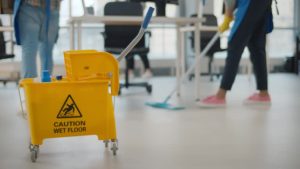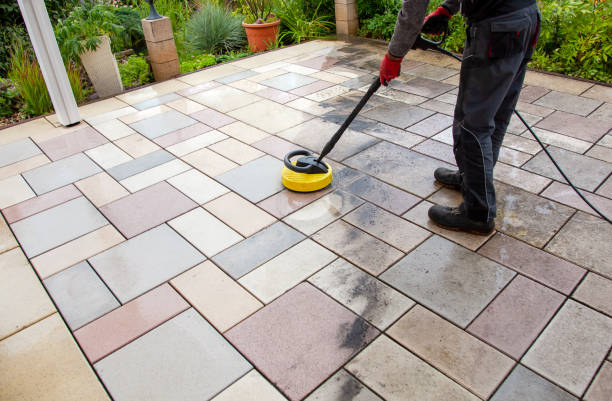Signs It’s Time to Strip and Wax Your Floors
The initiation of cleaning commercial floors can be a beast of a job. There’s no denying it’s a necessary evil, especially in spaces that witness a lot of foot traffic. But how does one know the timely yet crucial decision to strip and wax those hard-working floors? Let’s dive right in.
Appearance Looks Dull and Lifeless
You know that sparkle your floors had once upon a time? If they’ve lost their shine and look as dull as dishwater, that’s a glaring sign. Commercial floors are like the business card of your space—first impressions matter. Over time, dirt, grit, and scuff marks have a knack for making floors look tired and worn. Regular cleaning can only do so much. When, despite your best efforts, your floors still look like they’ve gone through World War III, it’s time to consider the big guns—stripping and waxing.

Unremovable Stains and Discoloration
Okay, imagine this: Your cleaning staff has tried every trick in the book to get rid of that coffee stain from last month, but it’s acting like it’s been painted on. No amount of elbow grease makes a difference. Such stubborn stains are not just eyesores; they scream neglect. When your floor starts looking like a Jackson Pollock painting, maybe it’s time to strip and wax.
Wax Build-Up is Out of Control
Have you ever seen wax build-up and thought, “Whoa, that’s a disaster waiting to happen”? Too much wax can create a slippery, hazardous surface. It turns your floor into an accident prone area, quite literally a slip-and-slide for anyone walking across it. If the buildup is thick enough to become noticeable—creating a gross, uneven surface—then stripping the old wax and applying a fresh coat should be on the menu.
Scratches and Scuffs Everywhere
Commercial floors experience a lot of abuse. People walk, drag things, drop items—it’s a floor’s daily life. Over time, this results in scuffs, scratches, and nicks that no amount of mopping will fix. These defects not only diminish aesthetic appeal but can also be breeding grounds for bacteria. If your floor looks like it’s been through a battle zone, stripping and waxing will rejuvenate its old charm.
Water Damage and Moisture Issues
Ever noticed that your floor has suspicious-looking patches that appear darker or warped? Moisture is the enemy of all floors, leading to more than a woo dingy look—it can cause permanent damage. Old wax layers can trap water underneath, making things worse. When signs of moisture damage are visible, it’s high time to address it seriously by stripping the floors bare and re-waxing them properly.
Increased Cleaning Efforts with Little Results
Are you finding that cleaning takes longer but yields poorer results? Maybe you’ve invested in top-notch cleaning products and an industrious team, yet the floors still look lackluster. This is often because the existing layers of wax have reached their limit. Stripping and re-waxing not only restore the floor’s appearance but also make daily cleaning more effective and less of a Herculean task.
Wearing Away of Protective Layers
Over the years, the layers of wax that protect your floor can wear thin. The floor might even start feeling rough to the touch, sometimes leading to more rapid wear and tear. Preventing further damage means keeping up with protective layers, so when they’re noticeably worn down, it’s time to strip and reapply.
Increased Allergy Complaints
If you’ve been hearing more sneezing and coughing around the office, it might be related to dirty floors. Old floors can accumulate allergens, dirt, and debris that regular cleaning can’t reach. A good stripping and waxing session will remove the built-up allergens and provide a fresh start, improving indoor air quality.
Can Your Floors Handle Stripping and Waxing? Let’s Find Out.
If you’ve been wrestling with cleaning commercial floors, you might have pondered whether stripping and waxing are safe for every kind of floor. This method might look like a surefire way to achieve gleaming surfaces, but it’s crucial to know that not all floors play nice with this procedure. Well, the same applies to floors. Time to dive deep into this topic, and figure out whether your floors can take the heat—or wax.
What’s the Big Deal with Stripping and Waxing?
First off, let’s get on the same page about what stripping and waxing entail. Stripping involves removing the existing layer of wax or finish from a floor, and then waxing it involves applying a fresh coat to give it that shiny, brand-new look. Sounds pretty straightforward, right? Well, here’s where the plot thickens: each flooring material responds differently to this process.
Hardwood Floors: A Love-Hate Relationship
Let’s chat about hardwood floors. Lovely to look at but can be divas if mistreated. You don’t want to strip these floors unless it’s absolutely necessary. Stripping could be like playing Russian roulette; you might end up damaging the wood. Instead, focus on proper maintenance and occasional refinishing. Works great without the risks associated with waxing.
Vinyl Floors: The Yes-Wax Zone
Got vinyl floors? Good news for you! Vinyl floors are like that easygoing friend who’s always down for a makeover. Stripping and waxing work well here. The primary concern is to avoid harsh chemicals which could cause discoloration. Otherwise, go ahead and dazzle your guests with sparkling vinyl floors.
Tile Floors: A Mixed Bag
Tile floors present a gray area. For ceramic or porcelain tiles, you generally don’t need to strip and wax. A simple mop or steam clean usually does the trick. However, VCT (Vinyl Composition Tile) floors come alive with regular stripping and waxing. But remember, incorrect treatment could leave these tiles looking dull.
Laminate Floors: Steer Clear
Here’s a tale of caution: laminate flooring and wax don’t mix. Laminate is essentially a photographic layer beneath a clear protective layer, and applying wax is like tossing a monkey wrench into the works. It can cause the surface to become slippery and dull. Better to stick to the manufacturer’s cleaning recommendations and keep it safe.
Natural Stone Floors: Handle with Care
Natural stone floors, like marble and granite, might look tough as nails, but they’re really as touchy as a cat in a room full of rocking chairs. Stripping might etch the stone and waxing can cause slip hazards. A well-sealed stone floor coupled with gentle cleaning is your best bet here.
Safety First
When dealing with stripping agents and floor waxes, precautions are essential. These chemicals can be as unforgiving as they are effective. Always follow instructions and use protective gear. No one wants an accident, right? Trust me, a little prep goes a long way.
The Economics of Floor Care
Here’s a kicker: Not every floor needs stripping and waxing, and sometimes doing it wrong can cost you a pretty penny. Incorrect handling can mean damaged floors which might require expensive fixes. Making informed decisions here can save both money and heartache.






